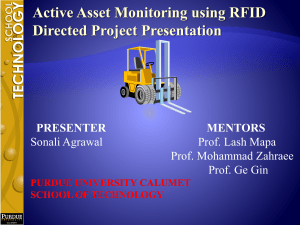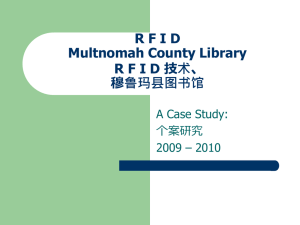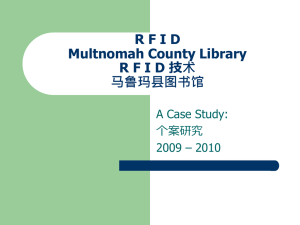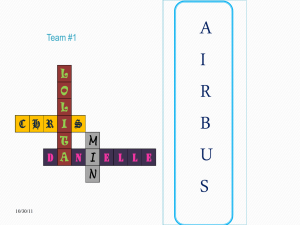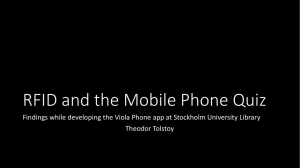The impact of RFID on library management systems* design
advertisement
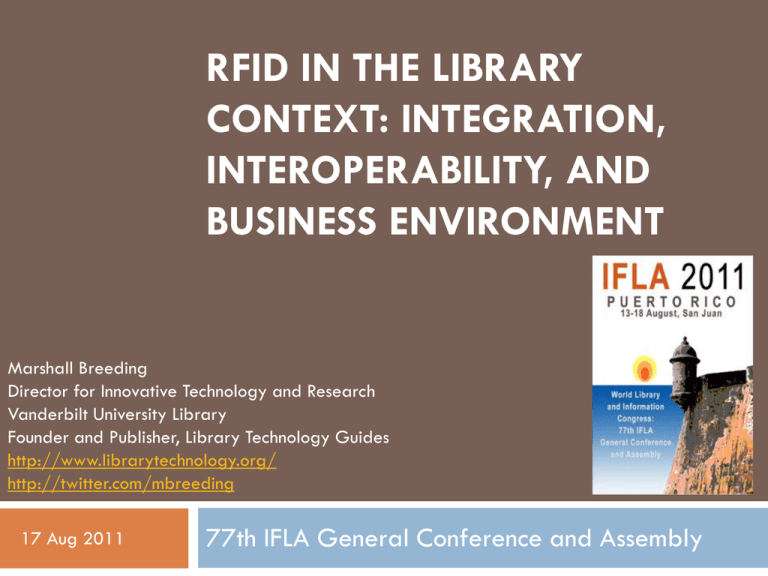
RFID IN THE LIBRARY CONTEXT: INTEGRATION, INTEROPERABILITY, AND BUSINESS ENVIRONMENT Marshall Breeding Director for Innovative Technology and Research Vanderbilt University Library Founder and Publisher, Library Technology Guides http://www.librarytechnology.org/ http://twitter.com/mbreeding 17 Aug 2011 77th IFLA General Conference and Assembly Summary Many aspects of technology supporting the automation of libraries are changing rapidly. Service-oriented architecture, Web-based computing, increased integration of social networking concepts, as well as cloud computing such as software-as-a-service characterize this emerging landscape. Products and services making use of RFID technology have to exist in an automation ecosystem increasingly reshaped by these technologies. Breeding will present a view of how RFID and related technologies fit into this evolving environment, some of the challenges involved such as the need for more modern protocols for interoperability, and some of the opportunities enabled for new efficiencies and innovations. He will also review some of the changes in the global RFID business landscape and comment on its implications for libraries that depend on their products and services. Library Technology Guides Library Technology Guides Includes lib-web-cats directory of libraries Tracks library automation products used by libraries: LMS, Discovery, Link resolvers, etc. Recently added section on RFID and related products Interest in collecting data on how these products have been implemented globally Lib-web-cats Technology Profile Koha Libraries Worldwide Lib-web-cats extended for RFID Products Lib-web-cats tech profile LJ Automation Marketplace Annual Industry report published in Library Journal: 2010: The New Frontier 2009: Investing in the Future 2008: Opportunity out of turmoil 2007: An industry redefined 2006: Reshuffling the deck 2005: Gradual evolution 2004: Migration down, innovation up 2003: The competition heats up 2002: Capturing the migrating customer The New Frontier… new phase of competition following a period of research and development that aimed to provide alternatives to libraries, both in back-end automation and end user discovery. A variety of new solutions have emerged, often representing quite different conceptual models. In a continued trend, librarians seek solutions that immediately improve the experiences of their users, especially via discovery products. Phase of realignment in LMS platforms Strong need to realign library automation with current library realities Legacy library systems reinforce workflows no longer in step with library priorities. Need systems that allow libraries to allocate personnel in proper proportion to collection Separate automation platforms for print and electronic have not proven successful Key Context: Technologies in transition XML / Web services / Service-oriented Architecture Local computing shifting to cloud platforms SaaS / private cloud / public cloud Beyond Web 2.0: Integration of social computing into core infrastructure Full spectrum of devices full-scale / net book / tablet / mobile Revised library automation priorities Fundamental assumption: Print + Digital + Social Print-focused models not adequate for modern libraries Libraries currently moving toward surrounding core ILS with additional modules to handle electronic content, social engagement, resource sharing, and self-service New discovery layer interfaces replacing or supplementing ILS OPACS Working toward a new model of library automation Monolithic legacy architectures replaced by fabric of SOA applications Comprehensive Resource Management “It's Time to Break the Mold of the Original ILS” Computers in Libraries Nov/Dec 2007 Working toward more Open Systems Achieving openness has risen as the key driver behind library technology strategies Open source Open API’s Demand for Interoperability Libraries need to do more with their data Ability to improve customer experience The Shrinking LMS The Library Management System no longer stands as the single library automation product that provides comprehensive support for all aspects of library operations. Many libraries putting much less emphasis on LMS Manages workflows related to physical materials Investments in electronic content increasing Management of e-content handled outside of the ILS Legacy LMS Model Public Interfaces: Staff Interfaces: Interfaces Business Logic Data Stores Circulation BIB Cataloging Holding / Items Circ Transact Acquisitions User Serials Vendor Online Catalog $$$ Funds Policies Breaking out of the mold Academic and Research libraries especially struggle with how to deal with managing increasing proportions of licensed electronic content Public Libraries seeking technologies that facilitate engagement with their users: social, interactive, dynamic LMS geared toward print materials New generation of products emerging to address new and emerging library realities Interoperability Protocols relevant to RFID Standard Protocols for access to item and patron data SIP NCIP Standard Protocols for access to bibliographic data OAI-PMH ILS-DI (Integrated Library System – Discovery Interface) Standard Protocols for access to other data and functionality API’s specific to automation platform Generalized set of API’s SIP: System Interchange Protocol • • • • • Initially created by 3M, used widely throughout industry for self-service and other tasks needing access to patron and item data and status in library automation systems. 3M: “Permission is hereby granted to utilize this protocol in hardware and software products but no permission is granted to create derivative works or otherwise modify the protocol” (from ver 2.0 document) Version 1: 1993 Version 2: 2006 Version 3: Draft currently under review NISO Circulation Interchange Protocol Official Standard designed to operate in the same space as SIP Z39.83 Part 1 approved October 2002; Part 2 Approved Nov 2008 Not widely adopted for self-service More widely used in resource sharing: interlibrary loan and direct consortial borrowing Open source NCIP Toolkit developed and released by the eXtensible Catalog project http://code.google.com/p/xcncip2toolkit/ Application Programming Interfaces Automation products cannot exist in isolated silos APIs provide a set of tools used by programmers to: Extend Functionality Connect external systems Extract or synchronize data Proprietary API’s common in LMS space Moving toward open API’s and Web Services Benefits of APIs to Libraries Extensibility Interoperability Allows the LMS to connect with other automation components Create a matrix of interconnected systems rather than isolated silos with redundant data and functionality LMS maturity means similar levels of functionality LMS products increasingly differentiated by extent and quality of APIs and interoperability support Legacy ILS Model / API Public Interfaces: Staff Interfaces: Interfaces Application Programming Interfaces Business ` Logic Data Stores Circulation BIB Cataloging Holding / Items Circ Transact Acquisitions User Serials Vendor Online Catalog $$$ Funds Policies Legacy ILS Model / protocol Interlibrary Loan System Public Interfaces: Staff Interfaces: Protocols: SIP2 NCIP Z39.50 OAI-PMH Application Programming Interfaces Circulation Cataloging Acquisitions Serials Online Catalog Self-Check BIB Holding / Items Circ Transact User Vendor $$$ Funds Policies Legacy ILS Model / External API External Systems & Services Public Interfaces: Staff Interfaces: Application Programming Interfaces / Web Services Circulation Cataloging Acquisitions Serials Online Catalog Flexible Interoperability Protocols: SIP2 NCIP Z39.50 OAI-PMH BIB Holding / Items Circ Transact User Vendor $$$ Funds Policies LMS as Middleware LMS provides strategic core of automation Less involved with end-user contact Discovery for Web-based collection discovery and user services Self-service stations for loans and returns Smart-card and payment systems Library Services Platform model Discovery Service Search: Self-Check / Automated Return Search Engine API Layer ` Consolidated index Library Management System Digital Coll ProQuest EBSCO … JSTOR Stock Management Other Resources Enterprise Resource Planning Learning Management Smart Cad / Payment systems Authentication Service RFID Business Environment Major RFID Companies 2CQR (UK) 3M Library Systems (also supports Checkpoint) Bibliotheca / Intellident / Bibliotheca ITG Book-Tech (Taiwan) Convergent Software (RFID support software, Validation) D-Tech (United Kingdom) EnvisionWare (diverse product line including RFID) Libramation (Canada) Lib~Chip RFID system Lyngsoe Systems (Sorting systems RFID/Barcode) mK Sorting Systms (RFID / sorting, self-check, etc) PV Supa (Finland, Scandinavia) Shenzen Seaever Inteligent Technology (China – RFID systems) Swisslog Telelift GmbH (book transportation systems) Tech Logic (Owned by TLC) VTLS – Fastrack VTLS division Consolidation Transition from a fragmented industry of many small players into one where dominated by large global companies Many companies continue to prosper that operate within a region or country Bibliotheca – Intellident – ITG Three former competitors joint to form new global company Integrated Technology Group – United States Spun off of Vernon Library Supplies Intellident Based Ident in the United Kingdom SAS (French subsidiary) Bibliotheca RFID Systems Based in Switzerland New Global Company Operates regionally under existing brands Bibliotheca ITG / Intellident / Bibliotheca Global company: Library Solutions BV Majority ownership: One Equity Partners Shai Robkin Diversification Companies involved in RFID tend to offer diversified products, often to different vertical markets Diverse technologies: RFID, Electromagnetic, software, hardware, manufacturing Different dependencies on suppliers of RFID chips, etc. 3M Library Systems Largest player in RFID and self-service Electromagnetic + RFIC products Major launch into the e-book arena 3M Cloud Library Intends to compete with Overdrive E-book content – licensed through major publishers Integration layer – leveraging SIP and other mechanisms developed in support of self-check E-book reader – developed for institutional lending In-library kiosk for discovery and download Intellectual Property Issues Patent dispute between 3M and EnvisionWare 3M filed patent infringement suit against EnvisionWare June 23, 2009 United States Patents involved in the suite include: 6,486,780, 6,232,870, and 6,857,568 USPTO ruled 6,486,780 patent awarded to 3M dealing as invalid USPTO review of 6,857,568 still in process Announcement of confidential private settlement on August 12, 2011 RFID Technology Issues Privacy Issues How much information to encode on tags Identifier only? Additional functionality available with more content Essential to avoid matching materials information with user User data can be read from non-library materials No public search of identifiers stored in tag RFID Data Encoding Standards • • • • • ISO Standards published in March 2011 ISO 28560-1:2011 ISO 28560-2:2011 ISO 28560-3:2011 NISO: Proposed that US libraries adopt Section 1 and 2 and develop a national profile RFID & LMS Can RFID deliver value beyond self-check and AMH? Need enhanced interoperability models Leverage existing standards and API’s in the same way that the ILS-DI protocols provided needed support to connect LMS and Discovery products Provide comprehensive automation model that helps libraries improve service and increase value to their communities General Observations Industry maturing with larger and more stable companies Increased development of Standards Helpful to the extend adopted Risks of investing in RFID diminishing RFID currently focused on increased efficiency RFID technologies increasingly positioned to support more innovative services Questions and discussion


